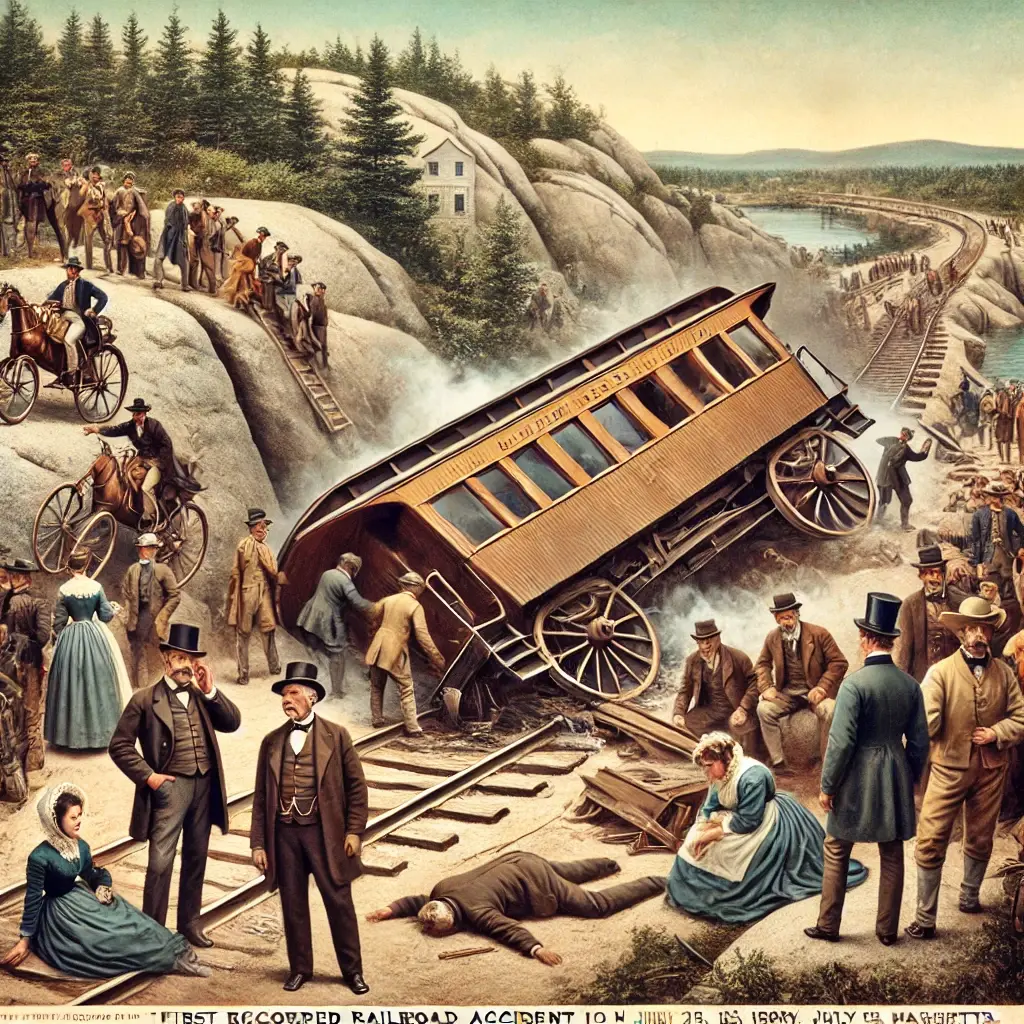On July 25, 1832, the first recorded railroad accident in U.S. history occurred on the Granite Railway near Quincy, Massachusetts. A cable on a wagon carrying a load of stone snapped on an incline, causing the wagon to hurtle back down the tracks and collide with another wagon. This accident resulted in one fatality and highlighted the emerging risks associated with the burgeoning field of railway transportation. It spurred early discussions on railway safety and eventually led to enhanced safety protocols and technology in the rail industry.
The Granite Railway, established in 1826, was one of the first railroads in the United States, primarily constructed to transport granite from the quarries in Quincy, Massachusetts, to the Neponset River for shipment to Charlestown. This early use of rail transport marked a significant technological advancement in the industrial age, enabling more efficient movement of heavy materials and laying the groundwork for the expansion of the railway system across the nation.
The accident on July 25, 1832, was a sobering reminder of the dangers inherent in this new mode of transportation. The Granite Railway was initially built to facilitate the construction of the Bunker Hill Monument, and its design included a series of inclined planes to manage the elevation changes. On the day of the accident, a cable on one of these planes snapped, sending a heavily laden wagon back down the slope uncontrollably.
This tragic incident resulted in the death of a laborer named Hugh O’Brien, who was struck by the runaway wagon. The accident not only underscored the perils faced by those working on and around the railways but also brought to light the need for stringent safety measures. At the time, railway technology was still in its infancy, and many aspects of its operation were experimental and rudimentary.

The Granite Railway accident prompted immediate scrutiny and concern among engineers, investors, and the public. The early 19th century was a period of rapid industrial growth, and the development of safe and reliable transportation systems was crucial to sustaining this momentum. The incident at Quincy highlighted the importance of safety in achieving this goal and spurred efforts to improve the reliability of railway technology.
One of the immediate responses to the accident was the introduction of more robust materials and better engineering practices. The Granite Railway and other early railroads began to implement stronger cables and braking systems to prevent similar incidents. These improvements were essential in making rail travel safer for both passengers and workers.
The 1832 accident also accelerated the development of regulatory frameworks for railway operations. As the rail network expanded, so did the need for standardized safety protocols. Governments and private companies started to establish guidelines and regulations to ensure that railroads operated within safe parameters, addressing issues such as track maintenance, wagon construction, and operational procedures.
The lessons learned from the Granite Railway accident had a lasting impact on the broader railway industry. Over the following decades, innovations such as the air brake, developed by George Westinghouse in 1869, revolutionized rail safety by providing more reliable and effective means of stopping trains. These advancements were crucial in reducing the frequency and severity of accidents.
In addition to technological innovations, the accident influenced the cultural perception of railway safety. Public awareness of the risks associated with rail travel grew, leading to increased pressure on companies and governments to prioritize safety. This shift in attitude was instrumental in fostering a culture of continuous improvement in railway operations.
The legacy of the Granite Railway accident extends beyond the realm of safety. It also played a role in shaping labor practices within the rail industry. The incident highlighted the need for better working conditions and protections for railway workers, who were often exposed to significant hazards. This awareness eventually contributed to the labor movement’s efforts to secure safer and fairer working environments for all industrial workers.
The Granite Railway itself continued to operate for many years, becoming a model for subsequent railway projects. Its pioneering spirit and the lessons learned from its early challenges helped pave the way for the extensive rail networks that would crisscross the United States by the late 19th century, facilitating commerce, travel, and economic growth.
The story of the first railroad accident in U.S. history is a testament to the resilience and ingenuity of early engineers and workers. Despite the tragic loss of life, the incident prompted a wave of innovation and reform that significantly enhanced the safety and efficiency of rail transportation. This process of learning from setbacks and striving for improvement remains a cornerstone of industrial progress.
In retrospect, the Granite Railway accident serves as an important historical marker, reminding us of the inherent risks of technological advancement and the critical importance of safety in engineering. It underscores the idea that progress often comes with challenges that must be addressed through careful study, innovation, and regulation.

The impact of the 1832 accident can still be felt today. Modern railways, with their sophisticated signaling systems, automated controls, and rigorous safety standards, are a direct result of the early lessons learned from incidents like the one at Quincy. These advancements have made rail travel one of the safest modes of transportation available.
Finally, the Granite Railway accident highlights the enduring importance of vigilance and proactive measures in ensuring safety. As new technologies and transportation methods continue to emerge, the principles of careful planning, robust design, and ongoing assessment will remain vital in preventing accidents and protecting lives. The legacy of this early tragedy is a reminder that safety must always be at the forefront of technological innovation.
